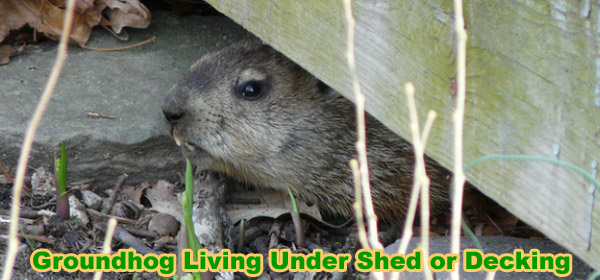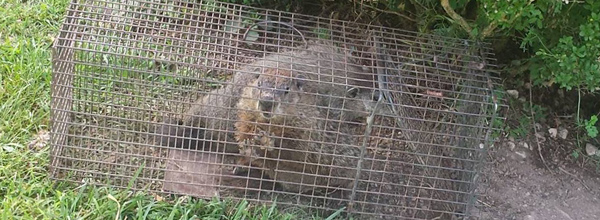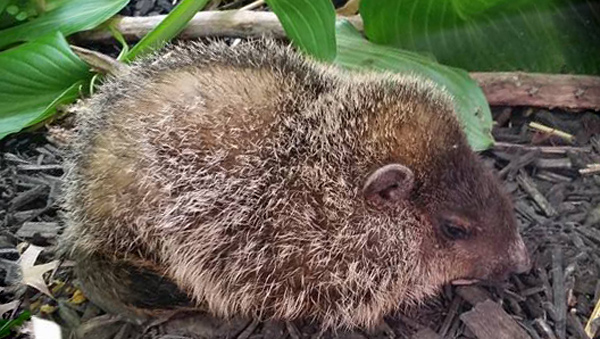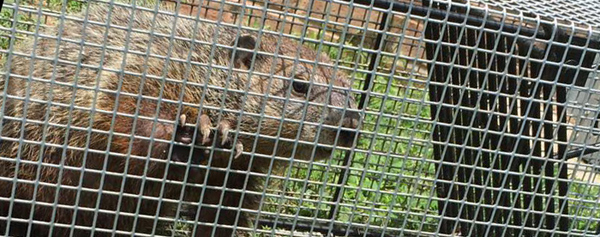- info@wildlife-removal.com
Call us for help in your town
Wildlife Removal Education
Groundhog Under My Shed or Deck
Need groundhog removal in your hometown? We service over 500 USA locations! Click here to hire us in your town and check prices - updated for year 2020.
If you want the simple, short-term solution, you trap and remove the animal. However, you're probably going to have another
animal problem in the future. All sorts of critters, including woodchucks, love to make a burrow or home under your shed,
deck, home, etc. You really need to install an exclusion barrier, a steel mesh fence, that goes all the way around the perimeter
of the shed or deck. It needs to go at least 18 inches underground, with the bottom curving outward, to stop diggers like
groundhogs from just digging underneath. If you install such a fence right away, while the animal is still living under there,
you can leave one little spot open as a prime place to set a trap or even a one-way exclusion door that lets it go out for
the last time, but not back in. Read more about Why Groundhogs Dig and Problems Caused by Groundhogs Digging.

How To Get Groundhogs Out From Under A Shed Or Porch - Groundhogs are rodents that are almost anonymous with some American holidays, but even though they are often seen as cute, if they find their way into a domestic area then they can be a big problem. Groundhogs are burrowing animals that will spend most of their time underground, but when they do burrow underneath a shed or porch then it can cause big problems for that structure. They will burrow an extensive network of tunnels under the shed or porch, and in some cases this can cause the ground to give way under the structure.
Avoid The Instinct To Try And Dig Out Or Seal The Burrow
For many people their first instinct will be to try and damage the burrow by digging into it or even sealing all the exits, but neither option is an effective way to solve the problem. Groundhogs are very defensive about their burrows, and trying to dig into the burrow is likely to aggravate the groundhog to attack, and they do have large front teeth that can deliver a nasty bite. Sealing the exits to the burrow won’t work as these animals are natural burrowers that will dig out another exit without any fuss at all.
The other challenge in trying to get a groundhog out from under the shed or porch is trying to do it without damaging the structure itself, and there are a number of more effective solutions available in this instance. Read more about how big groundhogs can get.
Lethal And Non-lethal Groundhog Solutions
Many people will want to use live traps to catch the groundhogs, but there are a number of problems that can be caused by such an option. Some states will have regulations about relocating a pest animal such as a groundhog, and this can make it difficult to trap a groundhog alive, because it is difficult to know what to do with it. Lethal trapping can also have legal ramifications, and it also gives people the unpleasant duty of having to deal with the carcass.
In order to trap a groundhog alive, most people will use a single catch trap that will snap shut the wall of the cage behind the groundhog, keeping it there until it can be checked and dealt with. The best bait for groundhogs is cantaloupe, which should be cut into chunks with some left outside the trap to invite the groundhog in. The trap should be placed very close to the exit of the burrow. Others will also have success in using sweet corn, strawberries and even vanilla extract as a bait to catch a groundhog.
In terms of lethal solutions to deal with a groundhog, people can choose a leg trap or a body trap, but many people in rural areas will actually shoot the groundhog. For those who choose to trap the animal, placing it directly outside the main exit to the burrow is vital, because this is where it is most likely to be successful. It can be baited with the same bait as the live trap. Read the guide What to Do With Groundhogs After Catching Them.
Repairing The Damage And Preventing Future Groundhog Issues
One of the biggest issues for people once they have removed the groundhog is how to repair the damage. If the groundhog has been under the shed or porch for some time then it could have moved up to 700 pounds of dirt underneath the structure. It will be hard for a layman to judge whether or not the shed or porch has been undermined, so checking with a professional may be a worthwhile expense.
Keeping the groundhogs out of your garden can be the best way to avoid the problem from occurring again, and an exclusion fence embedded into the ground, or an electric fence can be an effective way to keep the groundhogs out.
How Can You Remove Groundhog's From Your Shed or Porch?
Groundhogs are capable of causing extreme damage with their digging habit and are a major source of concern to many farmers and homeowners. They are known to be perfect burrowers and they are perpetually digging for grubs. Read the guide What is the Groundhog's Natural Habitat?

They particularly like to burrow under your shed or porch because of shade, relative warmth and a secure roof covering. They also feel safe and out of reach for the predators. It however, does not auger well for the property owner because of the rather expensive damage they could inflict on the property in no time.
Repellent solutions are very tempting and abundantly available to supposedly solve this problem. Unfortunately though, they have proven to be largely ineffective in getting the wood chucker to completely vacate the shelter of a shed or porch. At best, use them in combination with other deterrents.
What repellents do is to scare the groundhog away with an unpleasant taste or smell. Common repellents like mothballs, epsom salt, ammonia, predator urine and so on have been used to evict groundhogs by many people with little success. Another downside of these repellents is that you have to apply them repeatedly from time to time, as the unpleasant taste or odour usually goes away after a while or a rainfall. Read the guide What Groundhog Repellents Should I Use?
So what best works?
The use of live traps to catch and relocate groundhogs is popular and it is known to be very effective. You may hire or buy a live trap as they are readily available. Wash the trap to remove all human scent and thereafter, put on rubber hand gloves while handling it else the animal will perceive your scent and not go near such a trap.
Place the trap on level ground close to the opening of an identified burrow near your porch and disguise it as much as you can with dirt, twigs, and leaves. Bait the trap with banana, apple, or vegetables to lure the groundhog in. You may also douse your trap in some drops of ‘woodchuck lure’, this will attract the groundhog to it faster.
After the groundhog has been caught, transport the cage at least 10 miles away from your house and release the groundhog in a suitable location where it would thrive. You may also reach out to the local animal shelter for acceptable means of relocating your critter or to hand it over.
How Can You Remove Groundhog's From Your Shed?
Groundhogs and the extensive damage they can cause with their digging habit is a concern for many farmers and homeowners. They are known to be perfect burrowers and they are perpetually digging for grubs.

Groundhogs also love to nest under your shed or porch, where they continue their burrowing activities to the detriment of those structures. The shed or porch provides them with a covering that keeps such burrows dry, warm and out of the way.
A quick intervention is needed unless those woodchucks would cause some rather expensive damage to your property in no time.
To start with, do not try to seal up a groundhog's burrow. If you do this, aside from the fact that it can attack and bite you with its sharp teeth (groundhogs are highly defensive), it could also very simply find its way out by digging yet another channel.
Likewise, there is no magic repellent spray that would suddenly rid your shed or porch of a groundhog. Repellants rarely work on groundhogs, they are quite adept at ignoring, avoiding, or digging their way around the substance. Read the guide Are Groundhogs Good Pets?
Trapping
The most effective remedy to get rid of a groundhog denning under your shed or porch is by trapping and removing it. The use of live traps to catch and relocate groundhogs is popular and it is known to be very effective. You may hire or buy a live trap as they are readily available. Wash the trap to remove all human scent and thereafter, put on rubber hand gloves while handling it else the animal will perceive your scent and not go near such a trap.
Place the trap on level ground close to the mouth of an identified burrow under your porch and disguise it as much as possible with dirt, twigs, and leaves. Bait it with banana, apple, or vegetables to lure the groundhog in. You may also douse your trap in some drops of ‘woodchuck lure’, this will attract the groundhog to it faster.
After the groundhog has been caught, transport the cage at least 10 miles away from your house and release the groundhog in a suitable location where it would thrive. You may also reach out to the local animal shelter for acceptable means of relocating your critter or to hand it over.
Steps to Remove A Groundhog From Under A Shed Or Porch
Every animal wants safety and comfort, and groundhogs are not any different. They like staying under sheds and porches to keep themselves safe from predators as well as to provide shelter from the elements. Homeowners however have a problem with that because groundhogs are likely to cause some damage to the structure above them by making burrows that may ultimately lead to the collapse of the shed or porch. They are also going to make the structure look dirty and untidy by their activities. Whichever way, it is of considerable concern to the homeowner and thus, we seek for ways to get them out of there and gone.

While trying to get a groundhog out from under your shed or porch, there are a few things that you need to note:
- Don’t employ any method that will contribute to the damaging of the structure involved (shed or porch) by itself.
- Simply sealing the burrows where the groundhog is hiding cannot work, it will only force the groundhog to make more burrows, hence more damage to the shed or porch.
- Avoid using poisons especially where children or pets exist. The results may be disastrous if they come across such bait.
Check out these methods instead for use in getting a groundhog out of your shed or porch;
Live Trapping
The use of live traps to catch and relocate groundhogs is popular and it is known to be very effective. You may hire or buy a live trap as they are readily available. Wash the trap to remove all human scent and thereafter, put on rubber hand gloves while handling it else the animal will perceive your scent and not go near such a trap.
Place the trap on level ground close to the mouth of an identified burrow and disguise it as much as possible with dirt, twigs, and leaves. The trap should be baited with banana, apple, or vegetables to lure the groundhog In. you may also douse your trap in some drops of ‘woodchuck lure’, this will attract the groundhog to it faster.
After the groundhog has been caught, transport the cage at least 10 miles away from your house and release the groundhog in a suitable location where it would thrive. You may also reach out to the local animal shelter for acceptable means of relocating your critter or to hand it over.
Lethal Trapping
Lethal trapping is not a very humane method of eliminating groundhogs as the animals may not die quickly and will suffer while at it. These traps kill by putting great pressure on the spine and internal organs of the groundhog. They should be used as a last resort only when other methods have failed. Read the full guide Is it Legal to Trap A Groundhog?
Moreover, killing a groundhog is a temporary solution as other groundhogs would soon move in to replace it if other steps are not taken to exclude them.
Exclusion
This is a safe method that employs a one way exclusion door, which will be set over the burrow of the groundhog. When the groundhog comes out to eat, it would pass through the one way door, but it will be impossible for it to go back in through this door. Thus it is excluded from its hideout and it will have to find somewhere else to go.
You may thereafter exclude groundhogs from the whole of your yard with an exclusion fencing around the perimeter. Also ensure that all holes and spaces at the base of your shed or porch are sealed up with wire mesh, else other groundhogs would see them as an invitation.
Predate with Dogs
You may get a dog to guard over your shed or porch at night and early in the morning. Whenever the groundhog comes out of its burrow to find food, the dog would chase and probably catch it. Even if the dog is unable to catch this groundhog, it may scare away to never return.
Repellents
What repellents do is to scare the groundhog away with an unpleasant taste or smell. Common repellents like mothballs, Epsom salt, ammonia etc. have been used to evict groundhogs by many people with little success. One downside of these repellents is that you have to apply them repeatedly from time to time, as the unpleasant taste or odour usually goes away after a while or a rainfall.
After getting the groundhog out from under your shed or porch, you need to take measures that ensure they never get back in there. Besides, you need to repair any damage that may have been caused by the groundhog to the porch; you should probably call in an expert to help assess the extent of this damage and repair the shed or porch. They would also set up preventive checks to forestall a return of the rodents by building fence. Chicken wire fencing is commonly used for this purpose as it is quite economical to build.
Go back to the Groundhog Removal page or read more About Groundhogs.


















